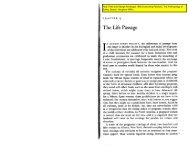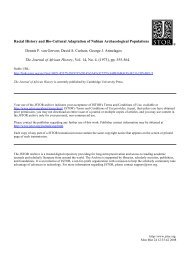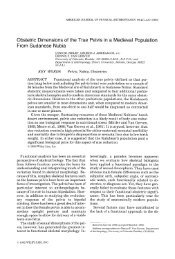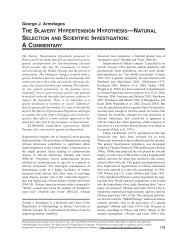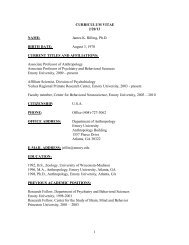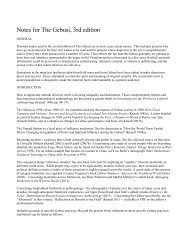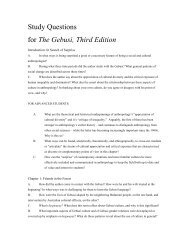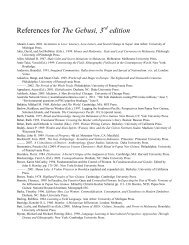Dennis P. Van Gerven George J. Armelagos ... - Anthropology
Dennis P. Van Gerven George J. Armelagos ... - Anthropology
Dennis P. Van Gerven George J. Armelagos ... - Anthropology
You also want an ePaper? Increase the reach of your titles
YUMPU automatically turns print PDFs into web optimized ePapers that Google loves.
<strong>Dennis</strong> P. <strong>Van</strong> <strong>Gerven</strong><br />
Department of <strong>Anthropology</strong>,<br />
University of Colorado, Boulder,<br />
Colorado 80309, U.S.A.<br />
<strong>George</strong> J. <strong>Armelagos</strong><br />
Department of Anthropolo~, University<br />
of Massachusetts, Amherst,<br />
Massachusetts, 01002, U.S.A.<br />
Keywords: paleo&mography, lijb,<br />
tables, skeletal age.<br />
Received 12 October 1982 and<br />
accepted 12 October 1982<br />
"Farewell to Paleodemography?" Rumors of<br />
Its Death Have Been Greatly Exaggerated<br />
Bocquet-Appel & Masset (1982) have recently proposed that<br />
paleodemography be abandoned in the light of two seemingly<br />
insurmountable deficiencies. First, they contend that the age structures of<br />
skeletal samples reflects nothing more than the age structures of their<br />
reference populations, that is to say, the samples by whose criteria they were<br />
aged. Second, they contend that age estimates made on adult skeletons lack<br />
sufficient accuracy to permit legitimate demographic analysis. Such<br />
estimates are, in the authors' view, nothing more than "random<br />
fluctuations and errors of method".<br />
The purpose of the present research is lo considcr Bocquet-Appel &<br />
Masset's assertions in light of the empirical evidence produced by<br />
paleodemography. Our results fail to support either of the authors'<br />
allegations. In fact, skeletal samples do not invariably reflect the structure<br />
of their reference populations and age estimates do not produce the random<br />
fluctuations predicted by the authors' a priori criteria for age estimation.<br />
Most importantly, our data indicates that the authors fail to consider the<br />
methods and accomplishments of paleodemography in their entirety and<br />
thereby present a biased and inadequate discussion of the salient issues.<br />
1. Introduction<br />
In a recent article entitled "Farewell to Paleodemography" Bocquet-Appel & Masset<br />
(1982) review and critically assess what they t~el to be the principal methods and<br />
accomplishments of paleodemography. They are particularly concerned with the accuracy<br />
by which individual skeletons can be aged, and with the degree to which skeletal ages can<br />
be combined into meaningful demographic profiles. Their assessment is far from<br />
encouraging. Beginning first with the creation of demographic profiles, the authors<br />
compare several skeletal populations with their reference populations, that is, the<br />
populations by which the skeletons were aged. For example, the age distribution of<br />
skeletons from ancient Nubia (Swedlund & <strong>Armelagos</strong>, 1969) is compared to the age<br />
distribution of the McKern-Stewart sample of Korean War dead by whose pubic age<br />
criteria the Nubians were presumably aged. On the basis of such comparisons the authors<br />
conclude that skeletal populations arc." doomed to emerge as demographic copies of their<br />
reference populations.<br />
The authors then proceed to the question of aging the individual skeleton. After<br />
considering various methods separately and combined, they estimate the highest<br />
correlation between chronological and skeletal age to be approximately 0"8. Based on a<br />
number of a priori criteria and assumptions, this level of accuracy isj udged to be completely<br />
inadequate. The authors suggest, for example, that in order to insure a 95% level of<br />
accuracy in age classification for a population whose actual ages range over a 72-year span,<br />
only 1"4 age categories can be meaningfully created.<br />
When then is the fate ofpaleodemography and those who continue to estimate ages and<br />
create age categories? The authors leave little doubt.<br />
The scholars who persist in this course will only obtain artifacts; the information conveyed by<br />
the age indicators is so poor that the age distributions thus available can hardly reflect anything<br />
but random fluctuations and errors o/method [emphasis ours] (Bocquet-Appel & Masset, 1982;<br />
p. 329).<br />
Journal ojHuman Evolulion (1983) 12, 353 360<br />
0047-2484/83/040353 + 08 $03.00/0 9 1983 Academic Press Inc. (London) Limited
354 D. P. VAN GERVEN AND G. j. ARMELAGOS<br />
The authors' farewell to paleodemography is clearly not a personal adieu but an obituary<br />
for the inquiry as a whole. Before the death becomes official, however, som e reappraisal of<br />
the author's diagnosis seems warranted. We intend to consider carefully whether the<br />
authors, themselves, have adequately and accurately portrayed the methods, objectives<br />
and accomplishments of paleodemography. It is our position that the methods employed<br />
by paleodemographers are far from inadequate. It is also our position that the results of<br />
paleodemography lend absolutely no support to the contention that they represent nothing<br />
more than "random fluctuations and errors of method". The authors' harsh appraisal must<br />
stand not only in light of their personal criteria but the criteria reasonably, conscientiously<br />
and successfully applied by others. We will then consider whether the authors have<br />
adequately considered and assessed the wider-ranging objectives and accomplishments of<br />
paleodemography.<br />
2. The Relationship Between Skeletal Samples and<br />
Their Reference Populations<br />
In order to determine whether skeletal samples are, as suggested by Bocquet-Appel &<br />
Masset, passive reflections of their reference populations, two skeletal samples from<br />
Sudanese Nubia were selected for analysis. The first represcnts 201 individuals excavated<br />
near Wadi Halfa and reported by Swedlund & <strong>Armelagos</strong> (1969). Although the reference<br />
population associated with this sample by Bocquet-Appel & Masset was the<br />
McKern-Stewart Korean War dead, the system most extensively used was that developed<br />
by Todd (1920) and later modified by Brooks (1955). The second sample consists of 162<br />
individuals excavated at the site of Kulubnarti (<strong>Van</strong> <strong>Gerven</strong> et al., 1981). This sample was<br />
also aged using changes in the os pubis as descibed by Todd and later modified by Brooks.<br />
Age categories for the two samples were arranged in five-year intervals from 15 through<br />
55+. This was also done for Todd's original sample (Todd, 1920). In order to facilitate<br />
statistical comparison, the data was then cast into cumulative mortality curves (Figure 1).<br />
Statistical comparisons between each skeletal sample and the Todd reference sample were<br />
made using the Kolmogorov-Smirnov two-sample test for cumulative frequencies as<br />
discussed by Siegel (1958) and Lovejoy (1971).<br />
As illustrated in Figure 1, differences between the Nubian samples and the Todd<br />
Figure 1. A comparison of cumula-<br />
tive mortality between two ancient<br />
Nubian populations and their refer-<br />
ence population based on Todd's<br />
(1920) analysis of 306 American<br />
males. [Kulubnarti (---), Wadi<br />
HalIR ( ), Todd ( .... ).]<br />
g<br />
d<br />
I00<br />
9O<br />
8O<br />
7O<br />
6O<br />
/ .-- o z<br />
20 /-~ //"<br />
,oL..~176<br />
15 20 25 50 55<br />
Age<br />
o/~ 5~<br />
o~ //~ /<br />
/o /<br />
// !<br />
/ .o<br />
o /<br />
.I-"<br />
/<br />
I I<br />
40 45 50 55*
"FAREWELL TO PALEODEMOGRAPHY~: A REPLY 355<br />
reference sample are extensive. With the exception of the first age category, all differences<br />
are significant at the 99% confidence level. Furthermore, the two skeletal samples are<br />
strikingly different from one another. These results in no way support the contention that<br />
skeletal samples correspond primarily to the age structure of their reference sample. The<br />
results do, on the other hand, correspond to previously observed differences among skeletal<br />
populations aged according to a common reference group. Green and co-workers (1974)<br />
for example, found important differences between skeletal samples from the site of<br />
Meinarti in Sudanese Nubia corresponding to periods of village growth and decline, they<br />
also found significant differences in life expectancy related to social status within the<br />
Meinarti population. It must be emphasized that all the Meinarti skeketal remains were<br />
aged in the same manner. Such differences, while making excellent biocultural sense, are<br />
difficuIt to explain if skeletal remains reflect only the demographic structure of their<br />
reference sample or random fluctuations and errors of method.<br />
3. The Determination of Age at Death From Skeletal<br />
Remains<br />
The second critical issue in Bocquet-Appel & Masset's "Farewell to Paleodemograpy"<br />
concerns the ability of skeletal biologists to assign accurately ages at death to skeletons.<br />
While they accept the utility of age-dependent criteria applied to subadults, the authors are<br />
far more skeptical of age-related changes in the adult skeleton. It is suggested that unless<br />
the correlation between chronological age and skeletal age reaches 0'9 or better, the<br />
prospects for paleodemography are dim. It is our contention that this a priori assessment is<br />
of little practical value in determining the actual utility of skeletal age data.<br />
In order to assess the impact of errors in age estimation, the sample of 306 males<br />
analysed by Todd (1920) for age changes in the os pubis were cast into a<br />
cumulative mortality curve based on their chronological ages. The sample was then cast<br />
into the same age categories based on pubic ages determined according to Todd without<br />
knowledge of chronological age. Pubic age values were derived from Todd's ten stage<br />
system by averaging the oldest and youngest age associated with each individual's stage<br />
assignment. All individuals whose oldest stage value was 10 (50+ years) were assigned to<br />
the 50-55+ age category. While this procedure may have resulted in our overaging some<br />
individuals classified by Todd as stage 9-10, it allowed us to avoid averaging his 50+ value<br />
as a fixed integer.<br />
As indicated in Figure 2, the cumulative frequency distributions created by<br />
chronological and pubic age data are strikingly similar and are in fact tied through the first<br />
two age groups. A maximum difference of 9% occurs at age 40 and is statistically<br />
significant. Difl~rences between all other age groups are not significant at the 95%<br />
confidence level. It is important to emphasize that the Todd system is seldom used in<br />
isolation. As Bocquet-Appel & Masset themselves demonstrate, the ability to assess age at<br />
death improves when multiple criteria are applied. Consequently, it is doubtful that<br />
skeletal age indicators produce nothing of interest for demographic purposes. Put another<br />
way, if the pubic ages derived from the Todd sample were our only basis for reconstructing<br />
their mortality profile, would it be reasonable to conclude that we had reconstructed<br />
nothing but "random fluctuations and errors of method"?<br />
As a final point, it must be recognized that the age distribution cannot be assessed<br />
beyond the 50-55+ category. While only a small percentage (usually between 1 and 10%)
35G D.P. VAN GERVEN AND G.J. ARMELAGOS<br />
of skeletal remains fall in this interval, Bocquet-Appel & Masset contend that this<br />
constitutes a major source of demographic error. They, however, offer little in the way of<br />
concrete support for their contention that a large portion of adults in prehistoric societies<br />
lived well into their 60s, 70s and even 80s. They site mortality among the Dobe !Kung as<br />
exemplifying what they believe to be a typical mortality pattern with mode adult mortality<br />
Figure 2. A comparison of cumula-<br />
tive survivorship based on chrono-<br />
logical age (---) and pubic age<br />
( .... ) estimates for a sample o["<br />
306 American males studied by<br />
Todd (1920).<br />
tO0<br />
90<br />
80<br />
70<br />
60<br />
50<br />
40<br />
50<br />
- 20-<br />
..~./~<br />
'~ F<br />
15<br />
o /<br />
20 25 30 35<br />
Age<br />
.,y<br />
o/<br />
...4,. o<br />
o /<br />
/,<br />
I k ~ I<br />
40 45 50 55+<br />
after 60 and even 70 years, however, this data constitutes little in the way of evidence either<br />
for prehistoric mortality or the Dobe !Kung themselves. Howell's (1979) analysis of Dobe<br />
!Kung mortality is based on developmental estimates of subadult ages which are then<br />
extrapolated to adult mortality estimates using model lifetables for modern populations!<br />
How this data can be cited as superior to paleodemographic reconstructions is not made<br />
clear.<br />
4. The Wider-Ranging Objectives and<br />
Accomplishments of Paleodemography<br />
If, as Bocquet-Appel & Masset suggest, paleodemographic reconstructions provide<br />
nothing more than random fluctuations and errors of method, the consequences of such<br />
errors and fluctuations should be apparent in all aspects of paleodemographic<br />
analysis--not simply in the construction of mortality profiles. It is important to emphasize<br />
that physical anthropologists have not limited their use of demographic data to questions of<br />
mortality and survivorship. Researches into paleopathology as well as growth and<br />
development have made abundant use of mortality data. The accomplishments of this<br />
large body of research must also be given consideration before paleodemography is laid to<br />
rest.<br />
Recent research into the age-related loss of skeletal tissue known as osteoporosis (Dewey<br />
el al., 1969; <strong>Van</strong> <strong>Gerven</strong> et aL, 1969) clearly illustrates the value of age data derived from<br />
skeletal remains. In order to determine whether ancient human populations experienced<br />
osteoporotic bone changes, Dewey and co-workers measured cortical bone thickness at the<br />
proximal one-third of femurs from 203 Nubians excavated near Wadi Halfa. The<br />
individuals are from the sample a portion of which was discussed earlier and illustrated in<br />
Figure 1. As previously indicated, all ages at death were determined in the field using
"FAREWELL TO PALEODEMOGRAPHY': A REPLY 357<br />
changes in the os pubis. Observations of cortical thickness were not a factor in age<br />
determination. Measurements of cortical thickness were made on isolated femur sections<br />
prepared in the physical anthropology laboratories at the University of Utah without<br />
knowledge of the age or sex of any specimen. After cortical thickness values had been<br />
obtained for the sample, the age data was added and mean cortical thickness was<br />
determined for four age groups as illustrated in Figure 3.<br />
o<br />
o<br />
-I0<br />
-us<br />
0<br />
-5<br />
g -20<br />
-25<br />
Figure 3. Percentage reduction in average cortical thickness (osteoporosis)<br />
for males and females in (a) a modern American and (b) Ancient Nubian<br />
sample.<br />
- o (a)<br />
>o<br />
O" \<br />
\<br />
- ~9<br />
\<br />
\<br />
I I I o<br />
21-30 51-40 41-50 51,<br />
o<br />
0<br />
5<br />
g~<br />
g o<br />
5<br />
- o (b)<br />
\o o-.d ~<br />
\<br />
-- \<br />
\<br />
_ x<br />
\O,<br />
x x<br />
"O<br />
I I<br />
16-2122-31 32-41 42-50+<br />
Age Age<br />
The results were then compared to the pattern of bone loss previously documented for a<br />
modern American sample (Bartley & Arnold, 1965) of known age using the same<br />
technique of cortical bone measurement. While the age groups used by Dewey do not<br />
correspond precisely to the modern series, the similarity between the ancient Nubian and<br />
modern American patterns of cortical bone loss is striking.* Both indicate a rapid rate of<br />
cortical thinning with advancing age among women with a much lower rate among men.<br />
Before we can conclude, as Bocquet-Appel & Masset do, that skeletal age data is<br />
spurious, it must be explained how observations of bone loss, made independently of age,<br />
could produce such a coherent pattern. Indeed, if Bocquet-Appel & Masset are correct,<br />
such an analysis of osteoporosis should have produced no discernible change in cortical<br />
thickness by age--that is, the relationship should have emerged as a random one.<br />
The successful application of a demographic approach to phenomena other than<br />
mortality has not been limited to osteoporosis. Lovejoy & Heiple (1981), for example,<br />
found a correlation of 0'97 between long-bone fractures and years at risk (determined from<br />
skeletal age) in a Late Woodland population from the Libben site in Northern Ohio.<br />
Beyond a simple measure of correlation, however, their demographic approach provided<br />
additional insight into the fracture process as it impacted different age groups. According<br />
to Lovejoy & Heiple (1981):<br />
Rates of fracture show marked elevation in two periods of the life cycle: adolescence/young<br />
adulthood and old age. These are the two periods of the life cycle in which one would most likely<br />
expect such high rates, if accidental trauma were the primary cause (p. 538).<br />
*In order to tacilitatc comparison, values beyond age 50 were combined by<br />
averaging in the modern sample.
358 D.P. VAN GERVEN AND G. J. ARMELAGOS<br />
These results also correspond closely to the pattern determined from a demographic survey<br />
of fractures in modern England and Wales (Buhr & Cooke, 1959) in which fractures<br />
associated with high levels of activity accumulated during the young years while other<br />
kinds of fractures accumulated during older age.<br />
Further examples could be cited but the point would be the same. When age-related<br />
events and processes affecting skeletal remains are examined independently of age<br />
estimation, i.e. demographically, their patterns of occurrence make sense in light of<br />
modern skeletal biology. In no case do the results reflect the random fluctuations and<br />
errors of method predicted by Bocquet-Appcl & Masset. The problem, therefore, seems to<br />
lie more with the authors' "farewell" and its underlying assumptions than with age<br />
estimation and paleodemography.<br />
Before concluding, one final issue must be addressed~ At the outset of their discussion,<br />
Bocquet-Appel & Masset acknowledged the accuracy with which age can be determined<br />
for subadult remains and accordingly exempt this segment of skeletal samples from their<br />
assessment. However, inasmuch as subadult remains regularly constitute over 50% of<br />
skeletal samples, and the authors conclude by dismissing all of paleodemography, some<br />
consideration of subadult remains and their value to paleodemography seems warranted.<br />
The Kulubnarti sample discussed earlier provides an excellent example of how valuable<br />
subaduh materials can be to paleodemographic analysis. A comparison of probabilities of<br />
dying and mean life expectancies between early and later Christian cemeteries at the site<br />
has revealed a higher mortality rate among subadults (birth through 14 years) during early<br />
Christian times (<strong>Van</strong> <strong>Gerven</strong> et al., 1981). In order to determine whether this difference is<br />
due to differences in childhood stress and morbidity, probabilities of dying within and<br />
between the two cemeteries were compared to frequencies of cribra orbitalia. Cribra<br />
orbitalia is a lesion of the superior surface of the eye orbit observed in many Nubian<br />
populations that has been related to dietary iron deficiency as well as parasitic and<br />
bacterial infections (Carlson, et al., 1974; <strong>Van</strong> <strong>Gerven</strong> et al., 1981). In both cemeteries the<br />
frequency of cribra orbitalia shows a high correspondence to probabilities of dying from<br />
infancy through the early adult years. Of even greater significance, the higher probabilities<br />
of dying among subaduhs in the early Christian cemetery correspond to higher frequencies<br />
of the lesion.<br />
These results support the contention that differences in childhood mortality from early<br />
to late Christian times are primarily due to differences in biological stress acting on these<br />
populations. It appears that the greater regional autonomy experienced by these people<br />
during the later Christian period was a positive influence on their biological well being. In<br />
terms of the issue at hand, it is particularly significant that subadult mortality is the most<br />
sensitive barometer of that biocuhural change.<br />
However, as with adult paleodemography, the analysis ofsubadults has not been limited<br />
to questions of mortality. For example, the analysis of bone growth and development,<br />
assessed independently of age determination, has been a major area of demographic<br />
inquiry.<br />
Studies of ancient Amerindian (johnston, 1962) as well as Nubian (Mahler, 1968;<br />
Hummert & <strong>Van</strong> <strong>Gerven</strong>, 1982) children have demonstrated important correspondences<br />
between prehistoric and modern growth patterns even though "... some degree of error of<br />
error is introduced by the very fact that the sample is skeletal. It does not represent the<br />
normal, healthy, population from which it was drawn" (Johnston, 1962, p. 249).<br />
Mahler, for example, found that the velocity and symmetry of long-bone growth among
"FAREWELL TO PALEODEMOGRAPHY": A REPLY 359<br />
ancient Nubians was broadly similar to that of modern Americans studied by Maresh<br />
(1955) with the exception that Nubians had a later and stronger adolescent growth spurt.<br />
Mahler hypothesized that the stronger growth spurt observed for the Nubians reflected<br />
catch-up growth resulting from an inadequate childhood diet and reduced pre-adolescent<br />
growth.<br />
Recently, Huss-Ashmore (1978) and Martin & <strong>Armelagos</strong> (1979) have investigated the<br />
nutritional basis fbr premature osteoporosis in juvenile and young adult Nubians and their<br />
results lend strong support to Mahler's earlier hypothesis. When long-bone length was<br />
plotted against cortical thickness and midshaft width for the Nubian sample, it became<br />
apparent that Nubian juveniles maintained long-bone length at the expense of normal<br />
cortical bone development. Following research carried out by Garnet al. (1966) on modern<br />
children, Huss-Ashmore suggested that this decrease in cortical bone may be evidence for<br />
protein-energy malnutrition in ancient Nubia. Here, then, we have a major new hypothesis<br />
created from demographic research on subadult remains.<br />
Studies such as this are not of simply passing importance, they represent a major arena<br />
of paleodemographic inquiry. Data produced by such research has provided important<br />
new insights into the dynamics of population adaptation as well as the biology of growth<br />
and development. And yet, if Bocquet-Appel & Masset are to be taken seriously, such<br />
research must either be dismissed or defined as non-demographic. In our view, neither<br />
solution is appropriate. We would prefer to acknowledge the real and important limitations<br />
within which all paleodemographers work, improve our methods when possible, and<br />
acknowledge the past, present and future value of paleodemographic inquiry.<br />
5. Conclusions<br />
In conclusion, for all of their grim projections and dire forecasts, Bocquet-Appel & Masset<br />
fail to account for one overriding fact; the results of paleodemographic research make<br />
sense. If demographic reconstructions are nothing more than passive reflections of their<br />
reference populations, important and bioculturally meaningful differences documented<br />
within and between skeletal populations should not exist, but they do exist. If age estimates<br />
combine to produce nothing more than random fluctuations and errors of method, such<br />
random fluctuations should be apparent in the study of age-dependent processes, but no<br />
such randomness is apparent. Most importantly, ifpaleodemography is to be dismissed, it<br />
should be found wanting in its entirety, but it is not. The authors ignore more than they<br />
consider. The study of subadult remains is entirely disregarded in their farewell as is the<br />
modern fluorescence in paleopathology and growth and development. These areas owe<br />
their current resurgence to a populational perspective provided by paleodemography.<br />
What, then, is the status ofpaleodemography? The answer is clear. Rumors of its death<br />
have been greatly exaggerated.<br />
References<br />
Bartley, M. H. & Arnold, J. S. (1965). Sex Differences in Human Skeletal Involution. Section III of Progress Report<br />
AM 09379 to National Institute of Arthritis and Metabolic Disease, National Institute of Health. United States<br />
Public Health Service.<br />
Bocquet-Appel, J. & Masset, C. (1982). Farewell to paleodemography. Journal of Human EvOlution 11, 321-333.<br />
Brooks, S. T. (1955). Skeletal age at death: the reliability of cranial and pubic age indicators. American Journal of<br />
Physical <strong>Anthropology</strong> I3, 567 597.<br />
Buhr, A.J. & Cooke, A. M. (1959). Fracture patterns. Lancet 1,531-536.
360 D. P. VAN GERVEN AND G. J. ARMELAGOS<br />
Carlson, D. S., <strong>Armelagos</strong>, G. J. & <strong>Van</strong> <strong>Gerven</strong>, D. P. (1974). Factors contributing to the etiology of cribra<br />
orbitalia in prehistoric Nubia. Journal of Human Evolution 3, 405-410.<br />
Dewey, J. R., <strong>Armelagos</strong>, G. J. & Bartley, M. H. (1969). Femoral cortical involution in three Nubian<br />
archeological populations. Human Biology 41, 13-28.<br />
Garn, S. M., Rohmann, C. G. & Guzman, M. A. (1966). Malnutrition and skeletal development in the preschool<br />
child. In Preschool Child Malnutrition, pp. 43-62. National Academy of Sciences-National Research Council,<br />
Washington, D.C.<br />
Green, S., Green, S. & <strong>Armelagos</strong>, G.J. (1974). Settlement and mortality of the Christian site (1050 A.D.-1300<br />
A.D.) of Meinarti (Sudan). Journal of Human Evolution 3, 297-311.<br />
Howell, N. (1979). Demography of the Dobe! Kung. New York, San Francisco & London: Academic Press.<br />
Hummert, J. R. & <strong>Van</strong> <strong>Gerven</strong>, D. P. (1982). Long bone growth in a population from Kulubnarti, Sudanese<br />
Nubia (55(>1450 A.D.). American Journal of Physical <strong>Anthropology</strong> 57, 198.<br />
Huss-Ashmore, R. (1978). Nutritional determination in a Nubian skeletal population. American Journal of Physical<br />
Anthroplogy 48, 407.<br />
Johnston, F. E. (1962). Growth of the long bones of infants and young children at Indian Knoll. American Journal of<br />
Physical Anthroplogy 20, 249-254.<br />
Lovejoy, C. O. (1971). Methods tbr the detection of census error. American Anthropologist 73, 101-109.<br />
Lovejoy, C. O. & Heiple, K. G. (1981). The analysis offi'actures in skeletal populations with an example from the<br />
Libben site, Ottowa County Ohio. American Journal of Physical Anthroploogy 55, 529-541.<br />
Mahler, P. E. (1968). Growth of the Long Bones in a Prehistoric Population from Sudanese Nubia. Thesis. University of<br />
Utah.<br />
Maresch, M. M. (1955). Linear growth of long bones of extremities ti'oru infancy through adolescence. American<br />
Journal of Diseases of Children 89, 725 742.<br />
Martin, D., & <strong>Armelagos</strong>, G. J. (1979). Morphometrics of compact bone: an example from Sudanese Nubia.<br />
American Journal of Physical Anthroplogy 51, 571-578.<br />
Siegel, S. (1956). Nonparametric Statistics for the Behavioral Sciences. New York: McGraw-Hill.<br />
Swedlund, A. C. & <strong>Armelagos</strong>, G.J. (1969). Un recherche en paleodemographie: la Nubia Soudanaise. Annales:<br />
Economic, Societes, Civilization 24, 1287-1298.<br />
Todd, T. W. (1920). Age changes in the pubic bone, I: the male White pubis. American Journal of Physical<br />
<strong>Anthropology</strong> 3, 285-344.<br />
<strong>Van</strong> <strong>Gerven</strong>, D. P., <strong>Armelagos</strong>, G. J. & Bartley, M. H. (1969). Roentgenographic and direct measurement of<br />
femoral cortical involution in a prehistoric Mississippian population. American Journal of Physical <strong>Anthropology</strong> 31,<br />
23-38.<br />
<strong>Van</strong> <strong>Gerven</strong>, D. P., Sandford, M. K. & Hummert, J. R. (1981). Mortality and culture change in Nubia's Batn el<br />
Hajar. Journal of Human Evolution 10, 39~408.



